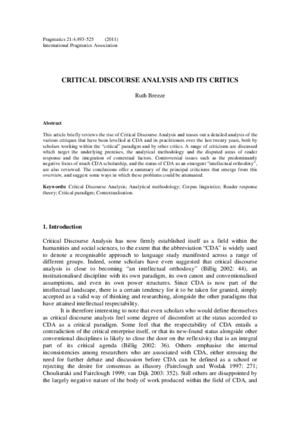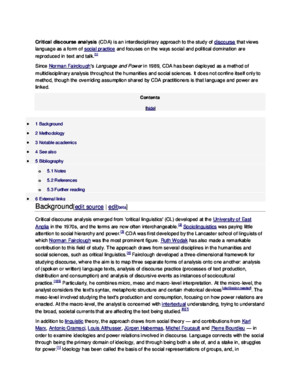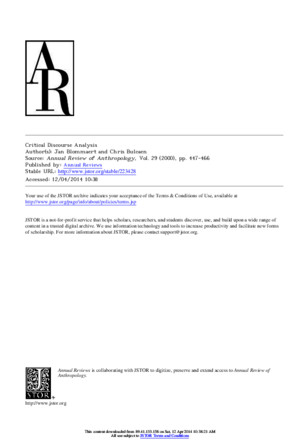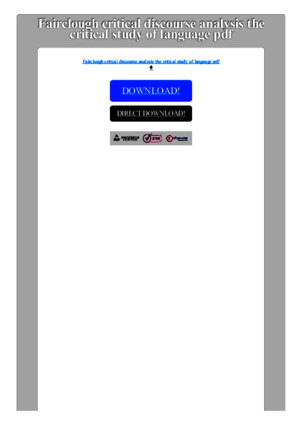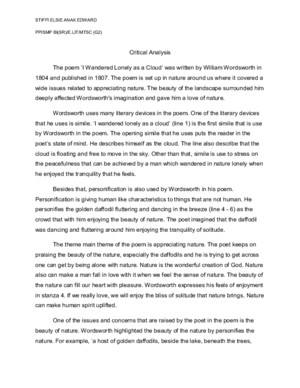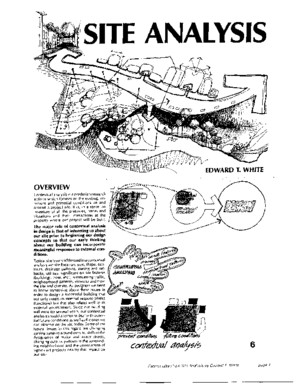Critical Discourse Analysis and Its Critics
There is document - Critical Discourse Analysis and Its Critics available here for reading and downloading. Use the download button below or simple online reader.
The file extension - PDF and ranks to the School Work category.
Tags
Related
Comments
Log in to leave a message!
Description
Download Critical Discourse Analysis and Its Critics
Transcripts
Pragmatics 21:4493-525 (2011) International Pragmatics Association CRITICAL DISCOURSE ANALYSIS AND ITS CRITICS Ruth Breeze Abstract This article briefly reviews the rise of Critical Discourse Analysis and teases out a detailed analysis of the various critiques that have been levelled at CDA and its practitioners over the last twenty years, both by scholars working within the “critical” paradigm and by other critics A range of criticisms are discussed which target the underlying premises, the analytical methodology and the disputed areas of reader response and the integration of contextual factors Controversial issues such as the predominantly negative focus of much CDA scholarship, and the status of CDA as an emergent “intellectual orthodoxy”, are also reviewed The conclusions offer a summary of the principal criticisms that emerge from this overview, and suggest some ways in which these problems could be attenuated Keywords: Critical Discourse Analysis; Analytical methodology; Corpus linguistics; Reader response theory; Critical paradigm; Contextualisation 1 Introduction Critical Discourse Analysis has now firmly established itself as a field within the humanities and social sciences, to the extent that the abbreviation “CDA” is widely used to denote a recognisable approach to language study manifested across a range of different groups Indeed, some scholars have even suggested that critical discourse analysis is close to becoming “an intellectual orthodoxy” (Billig 2002: 44), an institutionalised discipline with its own paradigm, its own canon and conventionalised assumptions, and even its own power structures Since CDA is now part of the intellectual landscape, there is a certain tendency for it to be taken for granted, simply accepted as a valid way of thinking and researching, alongside the other paradigms that have attained intellectual respectability It is therefore interesting to note that even scholars who would define themselves as critical discourse analysts feel some degree of discomfort at the status accorded to CDA as a critical paradigm Some feel that the respectability of CDA entails a contradiction of the critical enterprise itself, or that its new-found status alongside other conventional disciplines is likely to close the door on the reflexivity that is an integral part of its critical agenda (Billig 2002: 36) Others emphasise the internal inconsistencies among researchers who are associated with CDA, either stressing the need for further debate and discussion before CDA can be defined as a school or rejecting the desire for consensus as illusory (Fairclough and Wodak 1997: 271; Chouliaraki and Fairclough 1999; van Dijk 2003: 352) Still others are disappointed by the largely negative nature of the body of work produced within the field of CDA, and 494 Ruth Breeze call for critical scholars to pay more attention to positive or potentially transformative uses of discourse (Martin 2004: 183-4; Luke 2002: 106-7) At the same time, linguists and others who position themselves outside the borders of CDA have kept up a barrage of informed criticism which has pointed to many of the inconsistencies within the field of CDA These critics have brought to light problems with the epistemology and theoretical framework, most particularly the instrumentalisation of theory and the failure to establish an objective standpoint for research But they have also criticised the type of linguistic methodology that is often applied, as well as the underlying theories of language and communication, and they have shown how CDA researchers may fail to integrate context and audience satisfactorily into their analytical framework, leading to naively deterministic assumptions about the workings of discourse and social reproduction For these reasons, it is useful to review briefly the rise of Critical Discourse Analysis, particularly with a view to identifying its key tenets and teasing out its heterogenous intellectual antecedents, before carrying out a more detailed analysis of the various critiques that have been levelled at CDA and its practitioners, from both within and outside its disciplinary boundaries 2 A brief overview of critical discourse analysis 21 Defining critical discourse analysis In common with much of the bibliography on this subject, the introduction to this paper refers to Critical Discourse Analysis as an entity, a recognisable approach to language study or “program” (Wodak 2011: 50) It should be stated at the outset, however, that although such an approach undoubtedly exists and occupies a more or less defined area of the intellectual landscape, many scholars, particularly those working within this paradigm, feel that it is incorrect to refer to CDA as a unitary, homogeneous entity It is important to emphasise that, although for the purposes of the present study we shall consider “critical discourse analysis” as one tendency or movement which is both recognisable from the “outside”, as having common features, and self-aware, in the sense that its representatives believe themselves to be working within a “critical” paradigm as far as discourse analysis is concerned (Wodak 2011: 50), there are several identifiable “schools” or groups within CDA, and not all the points that will be made apply equally to all the groups or individual practitioners It is particularly important to distinguish between the initial British approaches embodied by Fairclough (1985, 1989) and Fowler (1991) and its later, more developed and coherent form explained in Chouliaraki and Fairclough (1999); the so-called “sociocognitive model” of critical discourse analysis epitomised by van Dijk (1991) and his group; and the Viennese “discourse historical school” led by Wodak (Wodak et al 1990; Wodak 1996, 2007) However, Wodak (2011) also distinguishes a French school of CDA that can be traced back to Pêcheux (1982), and to the influence of Bakhtin; a Duisburg school (Jäger 1999) which centres particularly on media language viewed in a Foucaultian perspective; and the approach advocated by Maas (1989) which scrutinises the way in which contradictions in society are inscribed in texts, and the way that readers are led to collude in ideological discourses For reasons of space, it will not be possible here to address each of these schools separately on all occasions; however, where possible, Critical discourse analysis and its critics 495 criticisms levelled at particular groups of analysts will be outlined, and exceptions identified For the purposes of the present paper, the term CDA will therefore be used in an inclusive sense, to mean the broad body of theory and research generated by specialists who regard themselves as critical discourse analysts in one sense or another This obviates the necessity to reduce the scope of reference constantly to “many critical discourse analysts” or “most people working within the CDA paradigm” However, since the use of CDA as an umbrella term entails the risk of over-generalisation, an attempt will be made to identify specific particular sub-groups or authors within the CDA tradition when this proves necessary As a self-conscious movement with an explicit agenda, CDA abounds in definitions of what it purports to be and do These declarations range from the highly politicised: “to explain existing conventions as the outcome of power relations and power struggle” (Fairclough 1989: 2), to the almost anodyne “to answer questions about the relationships between language and society” (Rogers 2005: 365), depending on the stance of the individual researcher However, the general consensus is that Critical Discourse Analysis contains two essential elements: A more or less political concern with the workings of ideology and power in society; and a specific interest in the way language contributes to, perpetuates and reveals these workings Thus the more explicit definitions all emphasise the relationship between language (text, discourse) and power (political struggle, inequality, dominance) “CDA takes a particular interest in the relationship between language and power () This research specifically considers more or less overt relations of struggle and conflict” (Weiss and Wodak 2002: 12) “CDA involves a principled and transparent shunting backwards and forth between the microanalysis of texts using varied tools of linguistic, semiotic and literary analysis, and the macroanalysis of social formations, institutions and power relations that these texts index and construct” (Luke 2002: 100) These initial definitions raise a large number of questions regarding what is meant by key terms such as “politics”, “power” and “ideology”, not to mention “critical”, “discourse” and “analysis”, which will be explored in the next section, in which the intellectual history of CDA will be briefly reviewed 22 Intellectual antecedents It is uncontroversial to state that the movement which is now recognisable as Critical Discourse Analysis began to gain momentum in the late 1970s, in a series of publications which initially set out to bring Halliday’s Systemic Functional Linguistics into a more broadly social perspective capable of taking in political issues of power and control “Language and Control”, by Fowler, Hodge, Kress and Trew (1979) and “Language as Ideology”, by Hodge and Kress (1993), were seminal works which laid many of the foundations for CDA without using the term itsef The term Critical Discourse Analysis itself appears to have first been used by Fairclough in an article published in 1985 (Fairclough 1985: 739), but was popularised by the highly influential book ‘Language and Power’ (Fairclough 1989) The term was consolidated by the
Recommended

